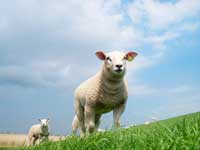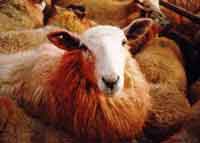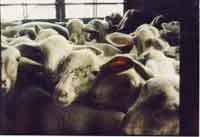Broken Body, Brave Heart
This story was being considered for a web feature, but I grabbed it for the blog because I found it to be incredibly moving. Please share Marcie’s story with your friends and family who still wear wool . . .
When a PETA member found Marcie languishing at a decrepit Colorado farm, she was sick, frightened, and going blind. She had been used as a breeding machine her entire life, and had endured the anguish of having all of her babies taken away as soon as they were born, sometimes even to be killed right in front of her.
 After the farmer agreed to relinquish Marcie, she was taken to the Peaceful Prairie Sanctuary, a refuge for abused and neglected animals. There, for the first time in her life, Marcie knew kindness instead of cruelty. She was given wholesome and plentiful food and the veterinary care she so desperately needed. But Marcie, shell-shocked and traumatized by her past, never fully recovered.
After the farmer agreed to relinquish Marcie, she was taken to the Peaceful Prairie Sanctuary, a refuge for abused and neglected animals. There, for the first time in her life, Marcie knew kindness instead of cruelty. She was given wholesome and plentiful food and the veterinary care she so desperately needed. But Marcie, shell-shocked and traumatized by her past, never fully recovered.
Despite the best of care, the damage was done: Marcie lost her sight within a year of her rescue. She was terrified of people—it was a year before shelter staff could even touch her—so she sought comfort and security among the goats at the sanctuary. In an effort to “hide,” Marcie camouflaged herself in the resident goat herd, forging a fast friendship with her bovid cousins.
In her final years, Marcie found contentment and peace. But for millions of sheep farmed for their wool, there is no happy ending.
 In Australia, where most of the world’s wool comes from, the misery for sheep begins when they are only weeks old. In a misguided attempt to prevent maggot infestation, or flystrike, farmers carve huge chunks of skin from the backsides of millions of lambs a year—without any pain relief—in a crude mutilation called mulesing.
In Australia, where most of the world’s wool comes from, the misery for sheep begins when they are only weeks old. In a misguided attempt to prevent maggot infestation, or flystrike, farmers carve huge chunks of skin from the backsides of millions of lambs a year—without any pain relief—in a crude mutilation called mulesing.
For 200 years, Australian farmers have intentionally bred, and continue to breed, merino sheep who have extra wrinkly skin because more skin means more wool and more profits. This extra skin collects moisture, urine and feces and attracts blowflies which lay their eggs in the wrinkly folds of skin. The hatched maggots can eat the sheep alive. Rather than spend the extra time and money on effective and humane methods to prevent flystrike, many farmers choose to simply cut the wrinkly skin off from the backside of lambs because it is cheaper and easier than caring for them properly.
 Shearing is also a painful, frightening ordeal. Shearers are usually paid by volume, not by the hour, so they work as quickly as possible, leaving sheep bruised and bleeding. The untreated wounds can attract flies and become infected. Terrified sheep who don’t “cooperate” are often beaten and kicked into submission. When they are no longer profitable for their wool, Australian sheep are often shipped thousands of miles to the Middle East, where they are dragged off trucks by their ears and legs, kicked in the face, and have their throats slit while they are still conscious.
Shearing is also a painful, frightening ordeal. Shearers are usually paid by volume, not by the hour, so they work as quickly as possible, leaving sheep bruised and bleeding. The untreated wounds can attract flies and become infected. Terrified sheep who don’t “cooperate” are often beaten and kicked into submission. When they are no longer profitable for their wool, Australian sheep are often shipped thousands of miles to the Middle East, where they are dragged off trucks by their ears and legs, kicked in the face, and have their throats slit while they are still conscious.
So, what can you do? Please, don’t ever buy any wool. Choose cotton, acrylic, polyester fleece, and other durable, stylish, and warm fabrics. Find sources of animal-friendly clothing at the PETA Mall and in our cruelty-free clothing guide. And click here for more ways to help.
